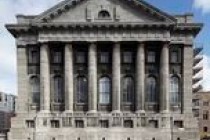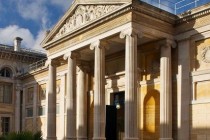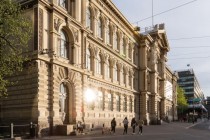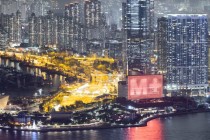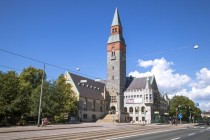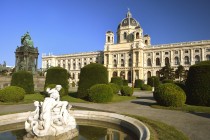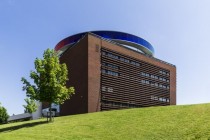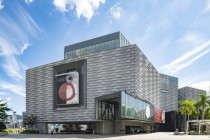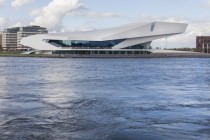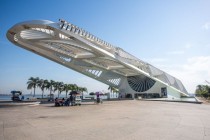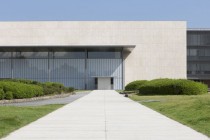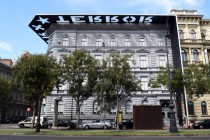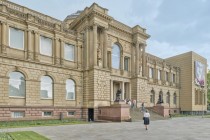National Maritime Museum opened in 2012.
The exhibitions focus on all aspects of marine and ocean life, from sea creatures to the history of the maritime industry based on 5,000 years of maritime culture. In the museum, you can see, among others, a replica of the Ship of Joseon Envoy.
Over 12,000 artefacts are presented at the exhibitions.
The museum covers an area of 45,444 square meters, including a total floor area of 25,870 square meters.
| Rank | Voting | Museum | Country | Location | Website | Type | More | |
|---|---|---|---|---|---|---|---|---|
| 266. | 246 | National Maritime Museum | South Korea | Busan | Maritime | More | ||
| 267. | 179 | Louvre-Lens | France | Lens | Art | More | ||
|
Louvre-Lens opened in 2012.
It is a satellite of Louvre, it has no collections of its own. It presents objects from the Louvre collection on loan in the medium to long term. The objects on loan represent all the Louvre collections and are renewed regularly. Louvre-Lens organizes temporary exhibitions of national or international importance. Louvre-Lens has three exhibition spaces: Grande Galerie, Glass Pavilion and the Temporary Exhibition Gallery. The museum covers 28,000 square meters. |
||||||||
| 268. | 269 | Altes Museum | Germany | Berlin | Art | More | ||
|
The Altes Museum opened to the public in 1830.
It is part of the Staatliche Museen zu Berlin belonging to Stiftung Preußischer Kulturbesitz. Currently, the Altes Museum houses the Antikensammlung (Collection of Classical Antiquities) and part of the Münzkabinett. The Antikensammlung is composed of the art of the Greeks (10th - 1st century BC), Etruscans and Romans. In addition to stone carvings and ceramics, you can see here products made of gold and precious stones. The Münzkabinett presents over 1,300 coins (7th century BC - 3rd century AD). Altes Museum Am Lustgarten, Museumsinsel Berlin, Berlin-Mitte © Staatliche Museen zu Berlin / David von Becker |
||||||||
| 269. | 407 | Pergamonmuseum | Germany | Berlin | Art | More | ||
|
Pergamonmuseum opened to the public in 1930.
It is part of the Staatliche Museen zu Berlin belonging to Stiftung Preußischer Kulturbesitz. The exhibition is divided into Antiquities Collection, Museum of the Ancient Near East, Museum of Islamic Art. The Pergamonmuseum collects monuments of ancient architecture, e.g. the Pergamon Altar, the Ishtar Gate. Pergamonmuseum Am Kupfergraben, Museumsinsel Berlin, Berlin-Mitte © Staatliche Museen zu Berlin / Maximilian Meisse |
||||||||
| 270. | 197 | Palácio Nacional de Mafra | Portugal | Mafra | Historic house | More | ||
|
The Palácio Nacional de Mafra (National Palace of Mafra) consists of a palace, basilica, convent (which includes a library), Cerco Garden and hunting park (Tapada). Built in the years 1717-1755 in the baroque and neoclassical styles. The entire complex covers 37,790 square meters with approximately 1,200 rooms.
As a museum, it officially opened to the public in 1911. Currently, the National Museum of Music is being moved to the palace complex. |
||||||||
| 271. | 160 | Real Alcázar de Sevilla | Spain | Seville | Historic house | More | ||
|
The Royal Alcázar of Seville (Real Alcázar de Sevilla) began to be built in the 10th century under the rule of the Moors. In 913, Abd ar-Rahman III of the Umayyad dynasty built a fortress. In the 12th century, the Almohads built, among others, Al-Muwarak Palace and gardens, which became the basis for later expansions. After the reconquest of Seville in 1248 by Ferdinand III of Castile, the alcázar became the seat of the Castilian kings. In the 14th century, King Peter I the Cruel commissioned the expansion of the palace in the Mudéjar style, which combines Christian and Moorish elements. During this period, among others, Palace of Peter I and Patio de las Doncellas (Courtyard of the Virgin). From the 16th to 18th centuries, new Renaissance and Baroque elements were added, such as the Galeria de Grutescos and the Palace of Charles V. The Royal Alcázar of Seville currently still serves as the royal residence during the visits of Spanish monarchs to Seville.
The Royal Alcázar of Seville has in its collections, among others, ceramics (Andalusian azulejos), a collection of Flemish tapestries from the 16th and 17th centuries, paintings (portraits of monarchs and historical scenes), and artifacts from excavations in the alcázar. The total area of the Royal Alcázar of Seville is approximately 9 hectares, of which the gardens occupy approximately 6 hectares. The gardens of the Royal Alcázar of Seville are designed in various styles, from Moorish to Renaissance and English. |
||||||||
| 272. | 195 | State Museum of History of Uzbekistan | Uzbekistan | Tashkent | National - archeology,... history, numismatics, ethnography | More | ||
|
The origins of the State Museum of History of Uzbekistan date back to 1876.
The core of the museum's collection are archaeological monuments and a collection of gold and silver coins. The artifacts come from Uzbekistan and Central Asia. The museum has, among others, an alabaster bas-relief of Buddha with Monks from Fayaz Tepe, Termez, 2nd century AD. The museum has collected over 300,000 exhibits. |
||||||||
| 273. | 245 | National Museum of Denmark | Denmark | Copenhagen | National - history,... archeology, anthropology | More | ||
|
The National Museum of Denmark (Nationalmuseet) founded in 1807.
It has collections from all over the world from the earliest times to the present day. In the museum from the area of Denmark you can see, among others: the Trundholm sun chariot from the Nordic Bronze Age, the Veksø helmets (a pair of ceremonial helmets with horns from the Bronze Age), runic stones. |
||||||||
| 274. | 325 | Salzburg Burgen & Schlösser Betriebsführung | Austria | Salzburg | Historic house | More | ||
|
Salzburg Burgen & Schlösser Betriebsführung (SBSB) - the Salzburger Burgen & Schlösser Management is a company-like institution of the Office of the Salzburg Provincial Government. SBSB started its operations in 1993. It consists of:
- Fortress Hohensalzburg, one of the largest existing castles in Europe from the 11th century, consisting of fifty buildings with a total area of 33,000 square meters; it houses: Prince's Chambers & Magic Theater, Armory, Panorama Tour, Castle Museum (a branch of Salzburg Museum), Rainer Regimental Museum, Puppet Museum. - Hohenwerfen Castle; it houses the following exhibitions: The Legend of Jackl - Wizards and Witches in Salzburg, Exhibition of the film "Where Eagles Dare". - Mauterndorf Castle; it houses the Lungau Country Museum - Salzburg "Residence" Palace |
||||||||
| 275. | 206 | Berardo Collection Museum | Portugal | Lisbon | Art | More | ||
|
The Berardo Collection Museum established in 2007, collects modern and contemporary art. Among the more than 1,000 works of art exhibited at the permanent and temporary exhibitions, you can see the works of Pablo Picasso. Salvador Dalí, Marcel Duchamp, Andy Warhol, Willem de Kooning, Jackson Pollock, Francis Bacon, Alexander Calder and Maria Helena Vieira da Silva.
|
||||||||
| 276. | 196 | Musée d'Art Moderne de Paris | France | Paris | Modern and contemporary... art | More | ||
|
A benchmark institution for modern and contemporary art
This is one of Europe’s greatest art museums. Located on Chaillot Hill in a building whose architecture is emblematic of the Art Deco period, the Musée d’Art Moderne de Paris is ideally suited to close-up study of the works on display. Its exhibitions and collections, which contain over 15,000 works in all, cover a period stretching from 1900 to the present day. The Musée d’Art Moderne was designed for the Paris International Exhibition in 1937 and is housed in the Tokyo Palace’s east wing. Officially inaugurated in July 1961, the origins of its collection date back to the early years of the 20th century, the result of a long series of initiatives taken by the City of Paris and such acts of generosity as Doctor Girardin’s bequest in 1953, which was the real deciding factor behind the decision to open the Museum, and the historic donations by Mathilde Amos in 1955 and Germaine Henry–Robert Thomas in 1976. Since the end of the Second World War, the Museum has acted as a trendsetter on behalf of a great many movements and artists: its programming is distinguished by its dynamism, originality and scientific rigour. Curiosity and the eye’s mobility ensure that the Musée d’Art Moderne de Paris remains an institution sensitive to the evolution of society, its concerns and its crises. Major artists in the history of art The MAM’s collections contain a total of 15,256 works by 2,322 artists and present the main artistic trends from the beginning of the 20th century to the present day, illustrated by major artists in the history of art, including Picasso, Dufy, Modigliani, Derain, Picabia, Robert and Sonia Delaunay, Suzanne Valadon, Christian Boltanski, Annette Messager, Philippe Parreno, Peter Doig, Elaine Sturtevant, Nina Childress, Danh Vo, Sheila Hicks and Judit Reigl. The Museum also possesses a number of rare and truly remarkable in situ works, including the first two versions of Matisse’s La Danse (The Dance), created in 1932 and 1931-1933, and Raoul Dufy’s La Fée électricité (The Electricity Fairy), a monumental work covering 600 square metres! Marked by major monographic exhibitions devoted to such artists as Jean-Michel Basquiat, Keith Haring, Sonia Delaunay, Andy Warhol, Bernard Buffet, Sarah Moon, Victor Brauner and Hans Hartung, the Museum’s programming is guided by the need to create a balance between exhibitions sure to be a success with the public, historical retrospectives focusing on internationally acclaimed artists, and exhibitions devoted to artists and artistic trends still little known in France. The institution also provides unexpected reinterpretations of art history, taking an innovative and very well documented approach, with such exhibitions as “Deadline” (2009), “L’Art en guerre” (Art at War – 2012), and “outsiders” projects highlighting such figures as Robert Crumb, Carol Rama, Henry Darger and Paula Modersohn-Becker, and the aesthetic ties and bonds of friendship between three artists in “Derain, Balthus and Giacometti” (2018), and the married couple Anni and Josef Albers. By taking an unconventional but critical look at contemporary visual creation in the 20th and 21st centuries, the Musée d’Art Moderne de Paris has confirmed its role as a “trailblazer”. Key figures 13,500 m2 of museum surface area 600 m2 Raoul Dufy’s La Fée électricité (The Electricity Fairy), one of the largest paintings in the world 600,000 visitors on average every year + 400 works exhibited free of charge + 15,000 works in the collections © : Louise Allavoine |
||||||||
| 277. | 210 | Museo Egizio | Italy | Turin | Archaeology | More | ||
|
Museo Egizio opened in 1824.
The Museo Egizio collects exhibits related to ancient Egypt. It has over 30,000 exhibits in its collection. In the museum, you can see monumental sculpture, including the statues of Ramses II and Seti II and the entire Temple of Ellesyia. A special place in the museum's collection is the collection of papyri containing a topographic map considered to be the oldest map in the world. |
||||||||
| 278. | 547 | Ashmolean Museum | United Kingdom | Oxford | University – art,... archeology | More | ||
|
Ashmolean Museum opened in 1683. The world's first university museum.
The museum's collection includes one of the most important collections of Pre-Raphaelite paintings, paintings by William Turner, John Constable, Claude Lorraine and Pablo Picasso. The archeology department boasts a collection of Greek and Minoan pottery (the largest outside Crete), artifacts from ancient Egypt and Sudan. An important place is occupied by the collections of majolica ceramics and English silverware. |
||||||||
| 279. | 178 | Denver Art Museum | USA | Denver | Art | More | ||
|
The origins of the museum date back to 1893, and since 1922 the museum has been operating under the name Denver Art Museum (DAM).
Collections: - Architecture and Design - Arts of Africa - Arts of Asia - Arts of Oceania - Arts of the Ancient Americas - European and American Art before 1900 - Indigenous Arts of North America - Latin American Art - Modern and Contemporary Art - Photography - Textile Arts and Fashion - Western American Art The Buildings: - Lanny & Sharon Martin Building (19.509 square meters) - Frederic C. Hamilton Building (13.563 square meters) - Bannock Administration Building (4.645 square meters) DAM has over 70,000 works of art. |
||||||||
| 280. | 293 | King Abdulaziz Center for World Culture | Saudi Arabia | Dhahran | Art, history, natural... history, ecology | More | ||
|
The King Abdulaziz Center for World Culture (Ithra) opened to the public in 2018.
Ithra is Saudi Aramco's flagship corporate social responsibility initiative and the largest cultural contribution in Saudi Arabia. Ithra includes a library, knowledge tower, idea lab, cinema, theater, Great Hall, energy exhibit, museum and children's museum. The museum part includes four galleries: - modern art - art and history of Saudi Arabia - Islamic art - natural history and ecology Ithra's collections include, among others, a folio from the Blue Quran and fragments from the Holy Quran from around 750 AD. Ithra covers an area of over 80,000 square meters. |
||||||||
| 281. | 168 | Palazzo Reale di Milano | Italy | Milan | Modern and contemporary... art | More | ||
|
Palazzo Reale di Milano (the Royal Palace of Milan) with medieval origins, renovated many times. In the years 1773-1778 restored in the Neo-Classical style, then the most famous interior of the Hall of the Caryatids (46 by 17 meters) was arranged, destroyed in 1943 during World War II.
In 1980, repair projects for the interior of the palace began in order to create a "Palace Museum", which, however, did not come into being. Currently, the Municipality of Milan organizes loud international exhibitions of modern and contemporary art in the palace. The Museum of the Duomo of Milan has been operating in the wing of the palace since 2013. The palace covers an area of 7,000 square meters. |
||||||||
| 282. | 171 | Finnish National Gallery | Finland | Helsinki | National - art | More | ||
|
The history of the Finnish National Gallery (Suomen Kansallisgalleria) begins in 1846. In 2014 it was reorganized and included:
- Ateneum Art Museum, its collection covers the period from the 18th century to modernism, permanent exhibitions present international and Finnish art, the collection includes nearly 30,000 works of art. - Museum of Contemporary Art Kiasma, has approximately 8,800 works of art in its collection. - Sinebrychoff Art Museum, specializes in old European art from the 14th century to the 1850s, the collections include approximately 6,500 works of art. - Finnish State Art Commission. Ateneum in the sun. Photo: Ville Malja |
||||||||
| 283. | 169 | Ephesus ancient city | Turkiye | Ephesus | Archaeological site | More | ||
|
Ephesus city founded in the 10th century BC. It flourished in ancient Greece and Rome. After which it was destroyed several times and finally abandoned in the 15th century AD. There are ruins in Ephesus, including:
- Temple of Artemis completed around 550 BC, which was one of the Seven Wonders of the Ancient World - a theater built in the 3rd century BC with approximately 25,000 seats - Celsus Library commissioned in AD 110 with approximately 12,000 scrolls - Temple of Hadrian from the 2nd century AD - a complex of terraced houses with frescoes from the 1st - 4th centuries AD Ephesus covers an area of 662.62 hectares. Finds from ancient Ephesus are exhibited in: - Ephesus Archaeological Museum in Selçuk - Ephesus Museum in Selçuk - İstanbul Archeology Museums - Ephesus Museum, Vienna - British Museum |
||||||||
| 284. | 200 | Stedelijk Museum Amsterdam | Netherlands | Amsterdam | Modern and contemporary... art and design | More | ||
|
The Stedelijk Museum Amsterdam was opened in 1895.
The collection covers art from the end of the 19th century to the 21st century. Contains works by artists such as Claude Monet, Vincent van Gogh, Paul Cézanne, Johan Jongkind, Pablo Picasso, Wassily Kandinsky, Kazimir Malevich, Piet Mondrian, Theo van Doesburg, Ernst Ludwig Kirchner, Marc Chagall, Henri Matisse, Henry Van de Velde, Henry Moore, Ossip Zadkine, Kurt Schwitters, László Moholy-Nagy, Man Ray, Jackson Pollock, Andy Warhol, Willem de Kooning, Nam June Paik, Lucio Fontana, Gilbert & George. The collection volume is 90,000 items. Exhibition area of 8,000 square meters. Stedelijk Museum Amsterdam, het historische gebouw en de nieuwbouw. Foto: John Lewis Marshall |
||||||||
| 285. | 185 | Liaoning Provincial Museum | China | Shenyang | Art, history, ethnography | More | ||
|
Liaoning Provincial Museum (辽宁省博物馆) was established in 1949 as the Northeast Museum.
The museum presents, among others: - jade from the Ming and Qing dynasties - porcelain from the Ming and Qing dynasties - ancient Chinese steles - ancient Chinese bronze mirrors - Chinese currencies - Chinese Buddhist statues - Liao dynasty pottery - seals of Chinese dynasties - the history of Liaoning from approximately 280,000 years ago to 1840 - Manchu folklore |
||||||||
| 286. | 225 | National Museum of the Republic of Kazakhstan | Kazakhstan | Astana | National – art,... natural history, archeology, ethnography, history, military | More | ||
|
The National Museum of the Republic of Kazakhstan (Qazaqstan Respýblıkasynyń Ulttyq mýzeıі) opened in 2014. It is one of the largest museums in Central Asia.
The museum presents the history and culture of Kazakhstan from prehistoric times to the present day. Permanent exhibitions include: - Central entrance - Atrium - Hall of Astana - Hall of History - Hall of Ancient and Medieval History - Hall of Gold 1 - Hall of Gold 2 - Hall of Kazakhstan Independence - Ethnography hall - Hall of Modern Art 1 - Hall of Modern Art 2 The symbol of Kazakhstan stored in the museum is the so-called "Golden Man" - these are the remains of an ancient ruler - a warrior in golden robes discovered near Almaty. The number of museum objects is about 220,000. The museum complex has an area of 74,000 square meters, of which the exhibition halls occupy 14,000 square meters. |
||||||||
| 287. | 196 | National Museum of Indonesia | Indonesia | Jakarta | Archeology, anthropology,... ethnography, art | More | ||
|
The National Museum of Indonesia (MusNas) dates back to 1778.
Museum collections of archeology, ceramics, ethnography, numismatics cover almost the entire history of Indonesia. Particularly noteworthy are the collection of stone statues from the classical Hindu-Buddhist period of ancient Java and Sumatra and the collection of Chinese ceramics dating from the Han (2nd century BC) to Qing times (18th century). MusNas stores nearly 200,000 artifacts in its collection. MusNas covers an area of 26,500 square meters. |
||||||||
| 288. | 163 | Canadian War Museum | Canada | Ottawa | National - military,... history, memorial, art | More | ||
|
The origins of the Canadian War Museum date back to 1880, but was formally established in 1942.
It functions as both a museum of Canadian military history and a memorial site. It is designed to emphasize the human experience of war. For the public it offers: Canadian Experience galleries, LeBreton Gallery, Memorial Hall, Regeneration Hall, Royal Canadian Legion Hall of Honor. Its collections include, among others: weapons, rare vehicles, uniforms, medals, art, documents, maps, sound and visual recordings, e.g. Mercedes-Benz car that belonged to Adolf Hitler, Chieftain and Mk III Valentine tanks, CF-101 Voodoo fighter. The entire collection includes over 3 million artifacts. The museum building covers an area of 440,000 square meters. |
||||||||
| 289. | 234 | National Gallery of Australia | Australia | Canberra | National - art | More | ||
|
National Gallery of Australia (NGA) founded in 1967, opened to the public in 1982.
Some NGA collections: - Australian Aboriginal and Torres Strait Islander art (the largest in the world) - Australian art (non-Indigenous), works by e.g. Sidney Nolan, Grace Cossington Smith, Margaret Preston, Arthur Boyd, Tom Roberts, Frederick McCubbin - Western art, works by e.g. Paul Cézanne, Pablo Picasso, Mark Rothko, David Hockney - Pacific art - Asian art - Sculpture garden, works by e.g. Auguste Rodin, Henry Moore The NGA has over 155,000 works of art. The NGA building has 23,000 square meters of floor space. |
||||||||
| 290. | 171 | Hubei Provincial Museum | China | Wuhan | Archeology | More | ||
|
Hubei Provincial Museum was founded in 1953.
The most valuable museum exhibits include artifacts from the tombs of the Marquis Yi of the Zeng state (including the Goujian sword and bronze bell set), Chu, Han, Liangzhuangwang and Yingjingwang, as well as fossils of human skulls from Yunxian Prefecture. The collection consists of over 230,000 objects. The total area of the museum is 50,000 square meters. |
||||||||
| 291. | 208 | Munchmuseet | Norway | Oslo | Art | More | ||
|
Munchmuseet (MUNCH) opened in 1963.
MUNCH is devoted to the life and work of the Norwegian artist Edvard Munch (1863–1944). MUNCH has nearly 1,200 paintings in its collection, which is more than half of the artist's entire painting output. MUNCH is in possession of the entire graphic heritage, in the number of 18,322 graphics with 842 different motifs. The Collection is completed by 7,050 drawings and sketches and 14 sculptures. It is one of the world's largest single artist collections. In addition, the collection includes original Munch photographs, printing plates and lithographic stones, handwritten texts and letters, as well as personal items. In total, the collection includes over 42,000 museum objects. |
||||||||
| 292. | 144 | Museum of Fine Arts | Hungary | Budapest | Art | More | ||
|
The Museum of Fine Arts opened to the public in 1906.
The collection is divided into 6 sections: ancient Egypt, ancient Greece and Rome, painting (13th-18th century), sculpture (from the Middle Ages to the 17th century), drawings and prints, art after 1800. The collection includes works by, among others, Domenico Ghirlandaio, Giorgione, Titian, Leonardo da Vinci, Tintoretto, Dürer, Lucas Cranach the Elder, Pieter Bruegel the Elder, Rubens, Frans Hals, El Greco, Velázquez, Goya, Eugène Delacroix, Jean-Baptiste -Camille Corot, Gustave Courbet, Édouard Manet, Claude Monet, Camille Pissarro, Pierre-Auguste Renoir, Henri de Toulouse-Lautrec, Auguste Rodin and Constantin Meunier. The number of works of art in the museum exceeds 120,000. |
||||||||
| 293. | 159 | Jewish Museum Berlin | Germany | Berlin | History | More | ||
|
The Jewish Museum Berlin was opened in 2001.
It is the largest Jewish museum in Europe. The museum presents the history of Jews in Germany from the Middle Ages to the present day from a Jewish point of view. The permanent exhibition "Jewish life in Germany: the past and the present", opened in 2020, covering an area of over 3,500 square meters, has more than 1,000 objects, of which over 70% comes from the museum's own collection. The museum's collection is divided into four areas: ceremonial and applied arts, fine arts, photography and everyday culture. © Jüdisches Museum Berlin, Foto: Jens Ziehe |
||||||||
| 294. | 203 | National Museum of Marine Science and Technology | Chinese Taipei | Keelung | National - maritime | More | ||
|
The National Museum of Marine Science and Technology (NMMST) officially opened to the public in 2014.
NMMST's interests focus on marine science, technology, ecology, and culture. The parts of the Museum Complex are the Main Exhibition Building, Ocean Theater, Regional Exploration Building, Research and Collection Center, Chaojing Intelligent Ocean (iOcean). NMMST is part of a larger entity called Marine Education and Tourist Park. It covers an area of over 500,000 square meters. |
||||||||
| 295. | 177 | M+ | China | Hong Kong | Art | More | ||
|
M+ opened in 2021 (https://www.museumworldranking.net/news/m-celebrates-its-opening-ahead-of-its-public-launch,114). M+ is part of the West Kowloon Cultural District.
M+ showcases a pre-eminent collection of twentieth- and twenty-first-century visual culture within an Asian context, encompassing the disciplines of visual art, design and architecture, and moving image from Hong Kong, Greater China, Asia, and beyond. The collection spans from 1895 to current. The M+ Collection and M+ Sigg Collection include 8,219 works as of September 2022. The 65,000-square-metre museum building comprises 17,000 square metres of exhibition space across thirty-three galleries. M+, Hong Kong Photo: Iwan Baan © Herzog & de Meuron Courtesy of Herzog & de Meuron |
||||||||
| 296. | 201 | Humboldt Forum | Germany | Berlin | Ethnography, art,... history | More | ||
|
The Humboldt Forum, open to the public in 2021, is located in the Berlin Palace on the Museum Island.
The Humboldt Forum houses the non-European collections of Berlin's state museums. The Humboldt Forum consists of the Stiftung Preußischer Kulturbesitz with the Ethnologisches Museum and the Museum für Asiatische Kunst der Staatlichen Museen zu Berlin, the Stadtmuseum Berlin together with Kulturprojekte Berlin, the Humboldt-Universität zu Berlin and the Stiftung Humboldt Forum im Berliner Schloss. Photo © SHF/Alexander Schippel |
||||||||
| 297. | 133 | The "Wieliczka" Salt Mine | Poland | Wieliczka | Mining | More | ||
|
The "Wieliczka" Salt Mine is one of the oldest rock salt mines in the world. The "Wieliczka" Salt Mine has more than 7 centuries of exploitation of the salt deposit, 2,391 chambers and 245 km of galleries, 9 main levels at a depth of 57 to 327 meters.
In the "Wieliczka" Salt Mine, on the 3rd level, at a depth of 135 meters, there is the Cracow Saltworks Museum in Wieliczka. The Cracow Saltworks Museum founded in 1951, apart from the underground part, also has a second part on the surface in the medieval Saltworks Castle. The museum presents the history of the mine, tools and devices used to extract and transport salt, and the history of the city of Wieliczka. The museum's collection consists of about 20,000 exhibits. |
||||||||
| 298. | 154 | Museu Nacional da Imprensa, Jornais e Artes Gráficas | Portugal | Porto | Media, technology,... art | More | ||
|
Museu Nacional da Imprensa, Jornais e Artes Gráficas (MNI, National Museum of the Press, Newspapers and Graphic Arts) founded in 1997.
MNI presents the historical processes of typesetting, printing and binding. The MNI has the International Cartoons Gallery. |
||||||||
| 299. | 186 | Salar Jung Museum | India | Hyderabad | National - art | More | ||
|
The Salar Jung Museum (SJM) was inaugurated in 1951.
SJM has artifacts from all over the world (33 countries) since the 2nd century BC until the beginning of the 20th century AD. These include the jade daggers of Jahangir and Shah Jahan, miniature paintings belonging to the Mughal and Rajasthani schools, probably the largest collection of "Bidri ware" in the world, the sculpture "Veiled Rebecca" by Giovanni Maria Benzoni, samurai swords, personal collection of the Salar Jung family, collection of the Koran, collection of clocks. In 1961, SJM was declared a national museum. The entire collection includes approximately 1.1 million artifacts. |
||||||||
| 300. | 204 | Museo Nacional de Arte | Mexico | Mexico City | National - art | More | ||
|
Museo Nacional de Arte (MUNAL) was founded in 1982 and is a branch of the Instituto Nacional de Bellas Artes (INBA).
The MUNAL collection presenting the history of Mexican art from the mid-16th century to the mid-20th century. The collection includes works by José María Velasco, Diego Rivera, Frida Kahlo, José Clemente Orozco and David Alfaro Siqueiros, among others. The permanent collection includes over 3,000 works and covers an exhibition area of 3,500 square meters. |
||||||||
| 301. | 185 | National Museum of Finland | Finland | Helsinki | National - archeology,... history, art, ethnology, numismatics | More | ||
|
The National Museum of Finland (Suomen kansallismuseo) opened to the public in 1916.
Permanent exhibitions: Prehistory, Otherland (history from the 11th to the beginning of the 20th century), Story of Finland (the independence era), Playtime (practical opportunity to experience things and study history). The entire collection includes approximately 3.5 million exhibits. The exhibition area is over 3,100 square meters. Photo is taken by: Omar El Mrabt |
||||||||
| 302. | 156 | Royal British Columbia Museum | Canada | Victoria | Natural history,... provincial history, archives | More | ||
|
The Royal British Columbia Museum (Royal BC Museum, RBCM) was founded in 1886. The museum merged with the British Columbia Provincial Archives in 2003.
RBCM collects First Nations artifacts, exhibits on BC history over the past 200 years, and natural history objects. All RBCM collections count over 7 million objects. |
||||||||
| 303. | 835 | National Archaeological Museum | Greece | Athens | National - archeology | More | ||
|
The National Archaeological Museum was founded in 1829.
The entire collections are divided into: - collection of prehistoric antiques (Neolithic, Cycladic and Mycenaean) - collection of ancient Greek sculptures (7th century BC - 5th century AD) - vase and minerals collection (11th century BC - Roman era) - metallurgical works collection - collection of Egyptian and Eastern Antiquities (5000 BC - Roman era) The National Archaeological Museum has in its collection, among others, the golden Mask of Agamemnon and the bronze statue of Zeus or Poseidon. The collection consists of over 11,000 exhibits. The museum covers an area of 8,000 square meters. |
||||||||
| 304. | 175 | Zaanse Schans | Netherlands | Zaandam | Open-air and living... history | More | ||
|
Zaanse Schans is a former residential and industrial district filled with many historic wooden windmills, houses, warehouses, shops and workshops.
In 1998, the Zaans Museum was opened, which currently has over 32,000 items in its collection. The museums open in Zaanse Schans are: Zaans Museum and Verkade Experience Albert Heijn Museum Shop Bakery Museum de Gecroonde Duyvekater The Zaanse Time Museum Jisper House Honig Breethuis Windmill Museum The windmills that can be visited in Zaanse Schans are: De Huisman De Kat De Gekroonde Poelenburg De Zoeker Het Jonge Schaap De Bonte Hen De Os Het Klaverblad De Bleeke Dood De Ooievaar Mini-mills on the Schans |
||||||||
| 305. | 241 | Natural History Museum Vienna | Austria | Vienna | Natural history | More | ||
|
The Natural History Museum (Naturhistorisches Museum Wien, NHM) opened to the public in 1889.
The entire collection consists of about 30 million objects. Of which over 100,000 objects are on display in 39 rooms with an area of 8,460 square meters. The collection includes, among others: - the Venus of Willendorf, about 29,500 years old - a sea mermaid that became extinct more than 200 years ago - dinosaur skeletons such as diplodocus, allosaurus and iguanodon - complete skeletons of large mammals, such as Deinotherium (hoe tusker) - the largest and oldest meteorite collection in the world, with the Martian meteorite "Tissint" © NHM Vienna, Kurt Kracher |
||||||||
| 306. | 213 | FC Barcelona Museum | Spain | Barcelona | Sports | More | ||
|
FC Barcelona Museum opened in 1984.
You can get acquainted with the history of the club thanks to the audiovisual touch screen. The sports art collection includes works by Salvador Dalí, Joan Miró and Antoni Tàpies. In the museum, we will also see the club's trophies and memorabilia, including those related to Diego Maradona and Lionel Messi. Entrance to the museum is combined with visiting the Camp Nou stadium. There is also a fan shop on the premises of the museum. The museum covers 3,550 square meters. Photo: FC Barcelona/Autor: Sara Gordon |
||||||||
| 307. | 170 | ARoS Aarhus Kunstmuseum | Denmark | Aarhus | Art | More | ||
|
ARoS Aarhus Kunstmuseum was founded in 1859.
It has a collection of artworks ranging from the early 19th century to the present with works by artists such as Grayson Perry, Robert Mapplethorpe, Joana Vasconcelos, Bill Viola, Olafur Eliasson, Paul McCarthy, Shirin Neshat, Lucian Freud and Francis Bacon. It has an area of 20,700 square meters. Foto Anders Trærup |
||||||||
| 308. | 274 | Albertina | Austria | Vienna | Art | More | ||
|
Albertina established in 1805.
Its collections include about 65,000 drawings and about 1 million graphics and photographs, including works by Dürer, Rembrandt, Rafael, Schiele, Cézanne, Picasso, Matisse, Klimt, and Kokoschka. Albertina Modern has been open to the public since 2020, bringing together over 60,000 works by 5,000 artists. |
||||||||
| 309. | 205 | Auckland War Memorial Museum | New Zealand | Auckland | Memorial, history,... natural history | More | ||
|
The origins of the Auckland War Memorial Museum date back to 1852.
Part of the museum is the War Memorial and the surrounding Court of Honor dedicated to those who died in World War I and II. The museum has collected 1.5 million natural specimens from the fields of palaeontology, botany, entomology, geology, terrestrial vertebrates and marine biology. The museum houses a large collections on the history of New Zealand, the Māori culture and the cultures of the Pacific region. The collections include three complete wooden buildings, including the Hotunui, a traditional Māori meeting house from 1878 from the Thames region, and the war canoe (waka) Te Toki a Tapiri from 1830. The Museum maintains the legacy of Edmund Hillary, the first man to reach the world's highest peak, Mount Everest, with Sherpa Tenzing Norgay. The area of the museum is 16,000 square meters. |
||||||||
| 310. | 213 | Natural History Museum Berlin | Germany | Berlin | Natural history | More | ||
|
The Natural History Museum - Leibniz Institute for Evolution and Biodiversity Science (Museum für Naturkunde [MfN] - Leibniz Institut für Evolutions und Biodiversitätsforschung) dates back to 1810.
MfN is one of the world's most important research institutions in the field of biological and geoscientific evolution and biodiversity. MfN has in its collections, inter alia, the largest mounted dinosaur in the world (a Giraffatitan skeleton) and the largest piece of amber in the world. MfN stores over 30 million objects in the field of zoology, palaeontology, geology and mineralogy, of which 0.02% is exhibited. The exhibition area is 4,400 square meters. Dinosaur Hall in the Museum für Naturkunde Berlin, visible, among others, a fragment of a Giraffatitan brancai skeleton. Photo: Thomas Rosenthal |
||||||||
| 311. | 184 | Hong Kong Museum of Art | China | Hong Kong | Art | More | ||
|
Hong Kong Museum of Art (HKMoA) was founded in 1962.
The entire HKMoA collection is divided into: - Chinese Antiquities, among others, Neolithic to 20th century ceramics, bronzes, jade carvings, lacquerware, enamelware, bamboo carvings - Modern and Hong Kong Art, covers over 100 years of painting, calligraphy, traditional ink painting - China Trade Art (18th, 19th century) - Chinese Painting and Calligraphy, consisting of paintings from Guangdong (among others Zhang Mu, Su Renshan), calligraphy from Guangdong (among others Chen Xianzhang, He Shaoji), Lingnan school of painting (among others Gao Jianfu, Chen Shuren), contemporary Chinese painting (among others Huang Binhong, Wu Guanzhong). The HKMoA collection includes over 17,000 items. |
||||||||
| 312. | 155 | National Gallery of Ireland | Ireland | Dublin | National - art | More | ||
|
The National Gallery of Ireland opened to the public in 1864.
It has collections of European and Irish art in its collection. It includes the works of, among others Titian, Rembrandt, Caravaggio, Velázquez, Rubens, van Dyck, Reynolds, Delacroix, Monet, Picasso, Jack Butler Yeats. The entire collection comprises approximately 14,000 works of art, including approximately 2,500 oil paintings, 5,000 prints and 5,000 drawings. |
||||||||
| 313. | 154 | Stockholm Palace | Sweden | Stockholm | Historic house | More | ||
|
The Stockholm Palace (Stockholms slott) is the official residence of the Swedish kings. Built in the years 1697 - 1771 in the baroque style, a large part of the interior is in the Rococo style. 230 meters long, 125 meters wide (with side wings). There are 1430 rooms in total. In addition to the Royal Apartments, the palace houses, among others, the Hall of State, the Royal Chapel, the Treasury with the Regalia of Sweden, the Royal Armory (Livrustkammaren) - over 30,000 artifacts, Gustav III's Museum of Antiquities, and the Museum Three Crowns (Museum Tre Kronor) - the Tre Kronor Palace, built in the Middle Ages and the Renaissance, on the site of which the present Stockholm Palace stands, burned down in 1697.
Photo: Kungl. Hovstaternas organisation |
||||||||
| 314. | 182 | Southern Branch of the National Palace Museum | Chinese Taipei | Taibao | National - Asian... art | More | ||
|
The Southern Branch of the National Palace Museum (NPMSB) opened in 2015.
NPMSB presents the art of Southeast Asia, East Asia and South Asia at permanent exhibitions. The presented artifacts were transferred from the National Palace Museum, Taipei (Northern Branch). NPMSB covers an area of 70 hectares, of which 20 hectares is occupied by the main building. |
||||||||
| 315. | 157 | Ayala Museum | Philippines | Makati | History, art, archeology,... ethnography | More | ||
|
The Ayala Museum, established in 1967, is run by the Ayala Foundation Inc.
The most important collections include archaeological, ethnographic, historical, fine arts, numismatics, and ecclesiastical exhibits. The Ayala Museum has, among others, 60 dioramas depicting the history of the Philippines from cavemen to the present day and a collection of over 1,000 gold objects from the 10th to 13th centuries. The Filipinas Heritage Library operates at the museum. |
||||||||
| 316. | 198 | Swiss Museum of Transport | Switzerland | Lucerne | Transportation | More | ||
|
The Swiss Museum of Transport (Verkehrshaus der Schweiz) was opened in 1959.
The museum presents the development of traffic and mobility by road, rail (including cableways), water and air, as well as space expeditions, telecommunications and tourism. An additional offer is the planetarium, Swiss Chocolate Adventure, Filmtheatre, Media World, and Hans Erni Museum. There are about 2,000 historic vehicles in the museum's collection. In addition, the museum has over 4,000 other exhibits related to the history of transport and over 15,000 documents related to this topic. |
||||||||
| 317. | 173 | Museo de la Ciencia CosmoCaixa | Spain | Barcelona | Science | More | ||
|
The Museo de la Ciencia CosmoCaixa, opened under its current name in 2004, is owned by the Fundación "la Caixa".
The main permanent exhibitions are "Sala Universo" with "Lab Math", "El Muro Geológico" with "Restos y Rastros", "Bosque Inundado", "Base Antártica". The museum also has a digital planetarium. The exhibition and educational area covers more than 30,000 square meters. |
||||||||
| 318. | 185 | Louisiana Museum of Modern Art | Denmark | Humlebæk | Modern and contemporary... art and design | More | ||
|
Louisiana Museum of Modern Art opened in 1958.
Louisiana has been collecting international art from 1945 to the present. It is mainly painting and sculpture (sculpture garden), but also design and photography. Its collections include works by artists such as Alberto Giacometti, Henry Moore, Asger Jorn, Alexander Calder, Yayoi Kusama, Pablo Picasso, Jean Arp, Yves Klein, Roy Lichtenstein, Andy Warhol, David Hockney, Cindy Sherman. The collection includes over 4,000 works. |
||||||||
| 319. | 271 | National Portrait Gallery | Australia | Canberra | Art | More | ||
|
The National Portrait Gallery has been operating as an unassisted institution since 1998.
The national collection of portraits includes about 3,000 photographs, paintings, sculptures, drawings and multimedia. |
||||||||
| 320. | 206 | Eye Filmmuseum | Netherlands | Amsterdam | Film | More | ||
|
The Eye Filmmuseum was established in 2010, its origins date back to 1946.
The Eye Filmmuseum has 2 exhibition halls (one of them covers an area of 1,200 square meters), a film archive and four cinemas. The museum collection covers the entire history of both Dutch and foreign film, from late 19th century silent films to contemporary productions, with a total of over 46,000 films. The collection also includes approximately 1,500 cinema projectors, 41,500 film posters, 500,000 photos, scripts, soundtracks and filmmakers' paper archives. The collection size is over 820,000 objects. |
||||||||
| 321. | 182 | Jakarta History Museum | Indonesia | Jakarta | History | More | ||
|
The Jakarta History Museum (Museum Sejarah Jakarta or Museum Fatahillah or Batavia Museum) was inaugurated in 1974.
The museum presents the history of the development of the city of Jakarta from prehistory to the present day. Its collections include, for example, objects related to the history of the Dutch East-India Company (VOC), Japanese ceramics from the 17th century, Batavia furniture, 17th-19th century, which is a combination of European, Chinese, Indian and Indonesian styles. The collection includes nearly 25,000 artifacts. |
||||||||
| 322. | 172 | Red Dot Design Museum Singapore | Singapore | Singapore | Design | More | ||
|
The Red Dot Design Museum Singapore was founded in 2005.
The Boutique Museum presents innovative product designs that have won the international Red Dot Design Award. |
||||||||
| 323. | 285 | Cleveland Museum of Art | USA | Cleveland | Art | More | ||
|
The Cleveland Museum of Art (CMA) opened to the public in 1916.
The CMA collections include art collections from all eras and from all parts of the world. The collections of Asian and Ancient Egyptian art stand out. In its collection, CMA has works by, among others, Sandro Botticelli, Caravaggio, El Greco, Peter Paul Rubens, Francisco de Goya, William Turner, Arnold Böcklin, Claude Monet, Pierre-Auguste Renoir, Vincent van Gogh, Paul Gauguin, Auguste Rodin, Pablo Picasso, Amedeo Modigliani, Salvador Dalí, George Bellows, Andy Warhol, Jackson Pollock, CMA's collection includes over 61,000 works of art. |
||||||||
| 324. | 151 | Frederik Meijer Gardens & Sculpture Park | USA | Grand Rapids | Sculpture park,... botanical gardens | More | ||
|
Frederik Meijer Gardens & Sculpture Park, opened in 1995, covers an area of 64 hectares.
There is a 30-hectare sculpture park with almost 300 cannons of Auguste Rodin, Edgar Degas, Henry Moore, Barbara Hepworth, Alexander Calder, Louise Bourgeois, Richard Serra. Ai Weiwei, Beverly Pepper, Jaume Plensa, Magdalena Abakanowicz and others. |
||||||||
| 325. | 229 | Museo Archeologico Nazionale di Napoli | Italy | Naples | Archeology | More | ||
|
The Museo Archeologico Nazionale di Napoli (MANN, National Archeological Museum of Naples) opened in 1816.
Main collections: - Farnese collection, e.g. marbles the Farnese Hercules, the Farnese Bull, jewel collection, - Ancient Roman artifacts from nearby Pompeii, Stabiae and Herculaneum, e.g. mosaics and the Secret Room, - collection from the time of ancient Egypt. The exhibition area is 12,650 square meters. |
||||||||
| 326. | 205 | Inner Mongolia Museum | China | Hohhot | Regional - natural... history, history, archeology | More | ||
|
The Inner Mongolia Museum opened in 1957.
The museum has an extensive collection of fossils, dinosaur remains, feathered dinosaurs and a complete woolly rhinoceros skeleton. One of the exhibitions dedicated to the history and traditions of the nomadic Mongols is devoted to the life of Genghis Khan, who in the 13th century united different Mongol tribes and founded one of the largest land empires. In the museum, you can also see the golden crown in the form of an eagle from the Warring States Period (475-221 BC). The collection includes over 150,000 exhibits. The museum covers an area of more than 50,000 square meters. |
||||||||
| 327. | 401 | Muzium Negara | Malaysia | Kuala Lumpur | National – history,... ethnology, natural history, art, numismatics | More | ||
|
Muzium Negara (National Museum) opened in 1963.
The exhibitions focus on the history of Malaysia, Islamic art, traditional crafts, fauna and flora of the Malay Peninsula. The museum covers over 4,170 square meters. In 1974, a wooden palace called Istana Satu from 1884 was moved and restored to the museum grounds. |
||||||||
| 328. | 188 | Osaka Castle | Japan | Osaka | History | More | ||
|
Osaka Castle was built at the end of the 16th century, made of wood, on two embankments of earth and hewn stones, surrounded by a moat. It was destroyed and rebuilt many times, currently it is a concrete reconstruction of the 17th-century Osaka Castle. There are 13 buildings in the castle, the main of which is a five-story tower.
The castle covers an area of over 6 hectares and is surrounded by 106 hectares of an open park. Currently, a historical museum called Osaka Castle Museum operates inside the castle. |
||||||||
| 329. | 188 | Middelheim Museum | Belgium | Antwerp | Modern and contemporary... art | More | ||
|
The Middelheim Museum (Middelheimmuseum) was opened in 1951 as the open-air sculpture museum. Then, for the needs of the museum, buildings were built successively: the Braem Pavilion, depot in Middelheim-Hoog, and the Het Huis pavilion (The house). The Middelheim museum has a branch called Art in the City active in all districts of Antwerp.
The collection consists of about 400 works of art. including works by artists such as Auguste Rodin, Constantin Meunier, Émile-Antoine Bourdelle, Aristide Maillol, Arturo Martini, Hans Arp, Ossip Zadkine, Barbara Hepworth, Henry Moore, Alexander Calder. The Middelheim Museum covers an area of 27 hectares. |
||||||||
| 330. | 285 | Crystal Bridges Museum of American Art | USA | Bentonville (Arkansas) | American art | More | ||
|
Crystal Bridges Museum of American Art opened in 2011.
The founding donor of the museum is the Walton Family Foundation. The museum's permanent collection covers American art from the colonial era to the present day. The collection includes paintings by Charles Willson Peale, Asher Durand, Thomas Eakins, Gilbert Stuart, Mary Cassatt, Benjamin West, Norman Rockwell, Agnes Pelton, John Singer Sargent, Jasper Johns, Jackson Pollock, Andy Warhol, Roy Lichtenstein, Mark Rothko, Georgia O'Keeffe, Edward Hopper and sculptures by Vanessa German, Roxy Paine, James Turrell. The museum buildings, covering an area of 20,200 square meters, are located in the almost 50-hectare park of the museum. In 2014, the museum acquired and reconstructed the Bachman–Wilson House by architect Frank Lloyd Wright. In downtown Bentonville, a satellite multidisciplinary contemporary art space dubbed The Momentary opened in 2020. |
||||||||
| 331. | 234 | Chhatrapati Shivaji Maharaj Vastu Sangrahalaya | India | Mumbai | History, art, archeology,... natural history | More | ||
|
Chhatrapati Shivaji Maharaj Vastu Sangrahalaya (CSMVS) opened to the public in 1922.
The museum houses over 50,000 artifacts from India, China, Japan and Europe. The museum documents the history of India from prehistoric times to the present day. The museum houses artifacts of the Indus Valley civilization and other relics from ancient India from the times of the Gupta, Maury, Chalukyas and Rashtrakuta; paintings of the major Indian schools of Mughal, Rajasthani, Pahari and Deccani; manuscripts from all over the last millennium; arts and crafts of ivory, jade, silver and gold. |
||||||||
| 332. | 155 | Swiss National Museum | Switzerland | Zürich | National – cultural... history, craftsmanship, artworks | More | ||
|
The Swiss National Museum was officially inaugurated on 25 June 1898.
The Swiss National Museum consists of: National Museum Zurich, Forum of Swiss History Schwyz, Château de Prangins, Collection Centre. The Swiss National Museum houses an extensive and diverse collection that spans Switzerland's cultural history from prehistoric times to the present day. With over 870,000 objects, the museum's holdings are organized into 14 distinct collection groups, each offering unique insights into various aspects of Swiss heritage. Key Collection Groups: - Archaeology: Artifacts from the Palaeolithic Age to the early Middle Ages, including significant prehistoric tools and Bronze Age items. - Silver and Non-Ferrous Metals: Sacral and secular goldwork objects from the 12th to the 21st century. - Graphic Arts, Photographs, Illuminated Manuscripts & Facsimiles: Drawings, graphic reproductions, illuminations, manuscripts, facsimiles, and historic photographs. - Ceramics & Glass: Medieval ceramic vessels, dishes made and used in Switzerland, figurines, sculptures, and reliefs. - Carriages, Sledges & Wagons: Representative examples of various carriages, magnificent sledges from different periods, and typical agricultural wagons. - Painting & Sculpture: Paintings emphasizing ecclesiastical and historical art, portraiture, and the world's largest collection of stained glass. - Furniture & Interiors: A comprehensive array of Swiss-designed and produced furniture, representing the largest public furniture collection in Switzerland. - Numismatics & Seals: Coins, medals, banknotes, securities, credit cards, coin-minting dies, and the most important collection of seals in Switzerland. - Jewellery & Timepieces: Jewellery from the 18th to 21st centuries and a representative cross-section of clockmaking over the last 500 years. - Special Collections: Toys, musical instruments (with a focus on military music), customs-related items, baking moulds, tin figures/casting moulds, and the Hallwil Collection. - Technology & Traditions: Objects from everyday life, crafts and trades, workshop equipment, computers, electrical devices, communication means, and measuring instruments. - Textiles & Fashion: Fabrics, clothing, accessories, traditional costumes, church paraments, and flags, including the most comprehensive textile collection in Switzerland. - Weaponry & Uniforms: Switzerland's most significant collection of weaponry from the High Middle Ages to the mid-20th century, along with uniforms, headgear, equipment, and decorations. - Witnesses to History: Artifacts reflecting social, political, economic, and cultural events shaping Switzerland from 1945 to the present day. The Swiss National Museum offers a total area exceeding 9,400 square meters. |
||||||||
| 333. | 319 | Apartheid Museum | South Africa | Johannesburg | Apartheid, history | More | ||
|
Apartheid Museum opened in 2001.
The museum illustrates the rise and fall of apartheid and the history of South Africa in the 20th century. The area where the Pillars of the Constitution, Journeys and 21 exhibition halls are located covers an area of 7 hectares. The exhibitions feature film materials, photographs and artifacts supplemented with texts, including those related to Nelson Mandela. |
||||||||
| 334. | 209 | State Museum of the History of St Petersburg | Russia | St Petersburg | Urban - history | More | ||
|
The State Museum of the History of St Petersburg was founded in 1938.
It consists of: Peter and Paul Fortress, Shlisselburg Fortress Oreshek, Rumyantsev Mansion, Alexander Blok Museum, Sergey Kirov Museum, St Petersburg Avant-garde Museum (Mikhail Matyushin's House), Monument to the Heroic Defenders of Leningrad, Museum of Printing. The museum has approximately 1.5 million documents, photographs, architectural drawings and plans of St. Petersburg from the 18th century to the present day. |
||||||||
| 335. | 263 | La Plata Museum | Argentina | La Plata | University – natural... history, anthropology | More | ||
|
La Plata Museum (Museo de La Plata) opened to the public in 1888.
The museum is divided into five sections: anthropological, botanical, geological, palaeontological and zoological, which at permanent exhibitions form a single whole depicting the evolution of nature, from the creation of the universe and our planet to the origin of man and its culture. La Plata Museum has, among other things, a collection of large mammal fossils from the third and fourth period of the Cenozoic era, pre-Columbian ceramics, objects from the excavations in the Aksha complex (Egypt, near the 1st cataract, 13th century BC). All collections amount to nearly 4 million objects. |
||||||||
| 336. | 173 | Musei Capitolini | Italy | Rome | Archeology, art | More | ||
|
The Musei Capitolini (Capitoline Museums) opened to the public in 1734. The Musei Capitolini are among the oldest museums in the world. The history of the museums dates back to 1471, when Pope Sixtus IV gave the people of Rome a collection of ancient bronzes and located them on the Capitoline Hill. Since then, the collection has been enriched with many ancient statues, works of medieval and Renaissance art, jewelry and coins.
The Musei Capitolini are located in Palazzo Senatorio, Palazzo dei Conservatori, Palazzo Nuovo, Palazzo Caffarelli, Galleria di congiunzione, Centrale Montemartini. Some of the biggest attractions are the sculptures: - Capitoline Wolf (5th century BC) - Cupid and Psyche (3rd century BC) - Dying Gaul (1st-2nd century AD) - Equestrian statue of Marcus Aurelius (c. 175 AD) - Bernini's Medusa (c. 1638-1648) The Musei Capitolini has 12,977 square meters of exhibition space. |
||||||||
| 337. | 177 | Guangdong Museum | China | Guangzhou | Art, cultural history,... ethnography, natural history, numismatics | More | ||
|
Guangdong Museum was founded in 1959.
Guangdong Museum collects: 1) Chinese art: - Ceramics: A large collection of pottery from various dynasties, including porcelain from the Tang, Song, Yuan, Ming and Qing dynasties, - Painting and calligraphy: Traditional Chinese paintings and calligraphy, both historical and contemporary, 2) Guangdong culture and history: - Historical Artifacts: Everyday objects, tools and artifacts that document the history and culture of the Guangdong region, - Ethnography: Objects related to ethnic minorities living in Guangdong province, 3) Natural history: - Fossils: Paleontological collections, including plant and animal fossils from various geological periods, - Zoological and botanical specimens: Collections related to the biodiversity of the region, 4) Arts and crafts and jewelry: - Artistic crafts: Objects made of wood, jade, metal and other materials, showing traditional craft techniques, - Jewelry and ornaments: Examples of traditional jewelry and ornaments from various historical periods, 5) Numismatics: - Coins and banknotes: Collections of coins and banknotes that illustrate China's financial and economic history. Guangdong Museum has approximately 166,000 exhibits in its collection. Of this number, approximately 13,000 exhibits are regularly exhibited in various museum exhibitions, both permanent and temporary. Guangdong Museum covers an area of approximately 67,000 square meters. The exhibition area of Guangdong Museum is approximately 21,000 square meters. |
||||||||
| 338. | 221 | Imperial Museum | Brazil | Petrópolis | Historic house | More | ||
|
The Imperial Museum (Museu Imperial) is located in the Imperial Palace, the former summer residence of Emperor Dom Pedro II of Brazil. The palace was built between 1845 and 1862 in the neoclassical style with elements of Renaissance architecture. After the overthrow of the monarchy in 1889, the palace became state property. In 1940, the palace was transformed into a museum. The official opening of the Imperial Museum took place in 1943.
The palace measures approximately 60 meters by 40 meters. The palace and its surrounding extensive gardens designed in a style inspired by European palatial residences cover an area of approximately 18.4 hectares. The main rooms of the palace are: - State rooms, such as the imperial salon and dining room, - The imperial office where Dom Pedro II worked, - Private rooms, including the bedrooms of the imperial family, - Library and archives where historical documents are kept, - The Coronation Hall, where the imperial insignia are displayed. The Imperial Museum's most important collections include: 1. Imperial Insignia and Regalia - One of the most famous and valuable exhibits is the imperial crown of Dom Pedro II, decorated with precious stones and made of the highest quality gold. - The museum also has other insignia of power, such as the imperial scepter and coronation robes, which symbolize imperial power in Brazil. 2. Collection of Imperial Furniture and Interiors - The museum contains original period furniture and furnishings, including elegant sofas, chairs, tables, beds and chests of drawers that were used by the imperial family. 3. Paintings and Portraits of the Imperial Family - The collection of paintings includes numerous portraits of Dom Pedro II, his wife, Empress Teresa Christina, and their children, including Princess Isabella. - There are also paintings by Brazilian painters depicting court life and landscapes from the era. 4. Outfits and Jewelry - The museum houses numerous costumes belonging to members of the imperial family, including ceremonial and everyday clothing, which reflect the fashion of the Brazilian aristocracy of the 19th century. - The collection also includes jewelry items such as brooches, necklaces and rings decorated with precious stones. 5. Historical Documents and Letters - One of the most important sections of the museum is the archive, which preserves manuscripts, letters, government documents and other writings related to Dom Pedro II, including his diaries and correspondence. 6. Book and Scientific Collections of Dom Pedro II - Dom Pedro II was passionate about science, and his book collection includes works from various fields such as astronomy, geology and literature. - There are also scientific instruments that the emperor used for scientific research and observations. 7. Souvenirs and Everyday Use Items - The museum's collection includes personal memorabilia of the imperial family, such as toiletries, watches, tableware, and everyday items that allow you to better understand their lifestyle. 8. Exhibits related to the Abolition of Slavery - The museum also contains items related to the Golden Law Decree of 1888, which was signed by Princess Isabella and ended slavery in Brazil. It is a key moment in the country's history and an important aspect of the museum's heritage. The Imperial Museum has approximately 300,000 exhibits. |
||||||||
| 339. | 245 | National Museum of Serbia | Serbia | Belgrade | National – art,... archeology, history, numismatics | More | ||
|
The National Museum of Serbia was founded in 1844.
The collections of the National Museum of Serbia include: 1. Art - European and Serbian paintings: The collection includes works by artists such as Monet, Cézanne, Van Gogh, Picasso and Serbian masters such as Nadežda Petrović, Paja Jovanović and Uroš Predić. - Icons and Sacred Art: Collection of Byzantine and post-Byzantine icons related to the Orthodox tradition of Serbia. 2. Archeology - Artifacts from the prehistoric era: Objects dating back to the Neolithic, Bronze and Iron periods, including famous finds from the Vinča culture. - Ancient collections: A rich collection of sculptures, ceramics, jewelry and coins from the times of ancient Greece, Rome e.g. the Belgrade Cameo (2nd - 4th century AD) and bronze bust of Roman emperor Constantine the Great (around 325), and the Byzantine Empire. 3. Numismatics - The museum has one of the largest numismatic collections in the Balkans, with coins and medals from antiquity to modern times. There are Greek, Roman, Byzantine, Serbian medieval, Ottoman and European coins. 4. Sculpture and applied art - Sculptures from antiquity to modern art, with particular emphasis on Serbian and European sculpture. - Applied art includes items such as ceramics, jewelry, fabrics and everyday objects from various eras. 5. Modern and contemporary art - Works by contemporary Serbian and European artists, including paintings, sculptures and installations. 6. Ethnography - Collections related to the material culture of the peoples living in the Balkans, including folk costumes, tools and objects of everyday use. The National Museum of Serbia has over 400,000 exhibits in its collection, and about 3,000 items are displayed in the museum's permanent exhibitions. The permanent exhibitions of the National Museum of Serbia cover an area of approximately 5,000 square meters. |
||||||||
| 340. | 136 | War Remnants Museum | Vietnam | Ho Chi Minh City | Military, history | More | ||
|
The War Remnants Museum was established in 1975.
The War Remnants Museum houses a vast collection of artifacts, photographs, and exhibits related to the Vietnam War and the broader history of war in Vietnam. Its collections include: 1. Military Equipment and Vehicles - Tanks, helicopters, fighter jets, and artillery. - A decommissioned "tiger cage" prison cell, used by South Vietnam to hold political prisoners. 2. Photographic Exhibits - A large collection of wartime photographs, including Pulitzer Prize-winning images. - Agent Orange and Napalm attack photos, showing their effects on civilians and soldiers. - Images from international war correspondents who covered the Vietnam War. 3. Weapons and Ordnance - Rifles, machine guns, grenades, bombs, and other wartime weaponry. - Defused cluster bombs and artillery shells used during the war. 4. International Anti-War Movement - Posters, newspaper clippings, and banners from global protests against the war. 5. Vietnamese Resistance and Victory - Displays on the Ho Chi Minh Trail, guerrilla warfare, and Viet Cong tactics. - Uniforms, personal belongings, and weapons used by North Vietnamese forces. - Victory celebrations and the fall of Saigon in 1975. The War Remnants Museum houses a collection of over 20,000 artifacts, documents, and photographs related to the Vietnam War. Of these, more than 1,500 items are selected for permanent display across its eight thematic exhibition halls. The War Remnants Museum in Ho Chi Minh City encompasses a total area of 7,548 square meters. This includes a three-story main exhibition building with a floor space of 4,522 square meters, and an outdoor exhibit area covering 3,026 square meters. |
||||||||
| 341. | 199 | Museum of Tomorrow | Brazil | Rio de Janeiro | Science | More | ||
|
Museum of Tomorrow (Museu do Amanhã) was opened in 2015.
The main exhibition is divided into Cosmos, Earth, Anthropocene, Tomorrow, and Us. The museum covers an area of 15,000 square meters, with the surrounding pools, gardens, bicycle path, and leisure area 34,600 square meters. Photo credits: Albert Andrade |
||||||||
| 342. | 279 | NEMO Science Museum | Netherlands | Amsterdam | Science and technology | More | ||
|
NEMO Science Museum was opened in 1997, however it dates back to 1923.
Exhibitions are devoted to electricity and electrical engineering as well as DNA, chain reaction, production line, water cycle, human mind, metals, buildings and business. Part of the exhibition is a large science laboratory. Consists of the NEMO Science Museum, The Studio, and NEMO Depot. It has a NEMO Schiphol branch at Amsterdam-Schiphol airport. The collection includes over 19,000 artefacts. © DigiDaan |
||||||||
| 343. | 228 | Kyoto National Museum | Japan | Kyoto | National - art,... archaeology | More | ||
|
Kyoto National Museum (KNM) opened in 1897. It has been using its current name since 1952. KNM focuses on pre-modern Japanese and Asian arts and crafts. Kyoto was the cultural and political center of Japan from the beginning of the Heian period in 794 to the end of the Edo period in 1868. KNM primarily collects cultural properties related to this "capital of a thousand years", Kyoto.
Collections that can be divided into several main categories: - traditional Japanese paintings, including hanging scrolls, screens, paintings on paper and silk from various historical periods, - Japanese calligraphy, including Buddhist texts, poetry and historical documents, - Buddhist sculpture, which is one of the key elements of Japanese art, there are both small and monumental sculptures made of wood, bronze and other materials, - decorative arts include ceramics, lacquerware, metalwork, textiles, and bamboo products, examples include everyday objects as well as ceremonial artifacts, - applied art includes objects such as swords, armor, theatrical masks, tea ceremony vessels, and various artifacts related to everyday life in Japan, - archaeological relics, - photographic archive containing over 200,000 photographic negatives and color slides. The museum contains over 12,000 works, half of which are displayed in exhibitions. KNM, including the gardens, covers an area of approximately 50,000 square meters. The exhibition area is approximately 7,000 square meters. Photo: exterior of the Kyoto National Museum, Heisei Chishinkan Wing |
||||||||
| 344. | 218 | Museo y Zona Arqueológica del Templo Mayor | Mexico | Mexico City | Archaeological park | More | ||
|
Templo Mayor - the most important religious building of the Aztecs. Its construction began after 1325. The expansion continued in six stages until it was destroyed by the Spaniards in 1521.
Templo Mayor was located in the center of the Aztec capital of Tenochtitlán, which is now Mexico City. Templo Mayor was the main building of the Sacred Precinct, which included 78 more smaller buildings. Templo Mayor was shaped like a stepped pyramid with two temples at the top. The architectural style of Templo Mayor belongs to the late post-classical Mesoamerican period. Approximate dimensions of Templo Mayor, base 100 by 80 meters, height 60 meters. The Museum of the Templo Mayor was opened in 1987. The Museo y Zona Arqueológica del Templo Mayor covers an area of over 3,000 ha. Photo: Secretaría de Cultura Ciudad de México, Attribution 2.0 Generic |
||||||||
| 345. | 203 | Istanbul Modern | Turkiye | Istanbul | Modern and contemporary... art | More | ||
|
Opened in 2004, Istanbul Modern is managed by a private venture under the patronage of a non-profit foundation called İstanbul Modern Sanat Vakfı İstanbul Modern Sanat Müzesi İktisadi İşletmesi. In 2023, Istanbul Modern moved into the new building (https://www.museumworldranking.net/news/istanbul-modern-hosts-renzo-piano-the-architect-of-its-new-museum-building,168).
Istanbul Modern focuses on Turkish art from 1945 to the present day. Turkish artists whose works can be seen in the museum include: Fahrelnissa Zeid, Bedri Rami Eyüböglu, Semiha Berksoy, Adnan Çoker, Bedri Baykam, Selma Gurbüz, Yıldız Moran. Istanbul Modern also has in its collection works by international artists (some with Turkish roots) such as: Fahrelnissa Zeid, Yüksel Arslan, Tony Cragg, Nil Yalter, Anselm Kiefer, Olafur Eliasson, Gülsün Karamustafa, Sarkis, Laure Prouvost, and Refik Anadol. Istanbul Modern has an area of 10,500 square meters. Istanbul Modern, Photo by Enrico Cano, 2023 |
||||||||
| 346. | 202 | Bangladesh National Museum | Bangladesh | Dhaka | History, art, archeology,... natural history, ethnology | More | ||
|
The historical origins of the Bangladesh National Museum is the Dacca Museum established in 1913. The Bangladesh National Museum was formally inaugurated in 1983.
The exhibitions are arranged chronologically from prehistory to the present day. The collection of gold, silver and copper coins from various periods of Bangladesh and Indian history is notable. The museum has one of the largest collections of armor and weapons in the Indian subcontinent. He is in possession of a large collection of paintings by Shilpacharya Zainul Abedin (1914-1976). One of the permanent exhibitions presents all phases of the Bengalis' struggle for political freedom, economic emancipation and cultural identity in the years 1757-1971. The Bangladesh National Museum occupies a building with a total area of nearly 18,800 square meters. |
||||||||
| 347. | 238 | Kiran Nadar Museum of Art | India | New Delhi | Modern and contemporary... art | More | ||
|
Kiran Nadar Museum of Art (KNMA) a private museum sponsored by the Shiv Nadar Foundation opened in 2010.
KNMA presents works from India, the subcontinent and South Asia from the late 19th to the 21st century. The collection includes over 8,000 works. The New Delhi location occupies more than 1,670 square meters and the Noida location more than 1,200 square meters of exhibition space. |
||||||||
| 348. | 381 | National Textile Museum | Malaysia | Kuala Lumpur | National - textile | More | ||
|
The National Textile Museum opened to the public in 2010.
The museum is divided into four galleries: 1. Pohon Budi Gallery presents the origin of textiles from prehistoric times to the present day and their development through trade, 2. Pelangi Gallery, among others, various types of batiks and their development over the years. 3. Teluk Berantai Galery, among others, a collection of gold embroidery, embroidered applications on velvet and silk, 4. Ratna Sari Gallery, Malay, Chinese, Indian and other ethnic artisan jewelry. It covers an area of 3,145.3 square meters. |
||||||||
| 349. | 342 | Vietnam Museum of Ethnology | Vietnam | Hanoi | National - ethnology | More | ||
|
Vietnam Museum of Ethnology (Bảo tàng Dân tộc học Việt Nam) opened to the public in 1997.
The 54 Vietnamese ethnic groups are featured in permanent exhibitions in the two-story Bronze Drum Building. The four-story Kite Building is an exhibition space for the cultures of peoples outside Vietnam, primarily from Southeast Asia. Architectural Garden outdoor exhibition on the area of 2 hectares presents ten works of folk architecture of ten ethnic groups in Vietnam. The collections include over 30,000 artifacts. The entire museum covers an area of 4.38 hectares. |
||||||||
| 350. | 204 | House of Terror Museum | Hungary | Budapest | Memorial | More | ||
|
The House of Terror Museum was opened in 2002.
The House of Terror Museum is a memorial to the victims of the fascist and communist regimes in 20th-century Hungary. In the museum, you can see, among other things, the cells in which ÁVH (Államvédelmi Hatóság - communist secret police 1945–1956) held prisoners and the T-54 tank. |
||||||||
| 351. | 206 | Petersen Automotive Museum | USA | Los Angeles | Motorization | More | ||
|
The Petersen Automotive Museum was founded in 1994. The museum was created thanks to a donation from Robert E. Petersen, a publisher of automotive magazines, who had a passion for cars and wanted to create a space to present the rich history of the automotive industry.
The Petersen Automotive Museum has one of the largest and most diverse vehicle collections in the world. It includes over 300 vehicles (about half of them on exhibition) that represent a wide cross-section of automotive history, technological innovation, design and car culture. Here are some of the main types of collections you can see there: 1. Vintage and classic cars. The collection includes many classic vehicles from the early 20th century, including cars from 1900 to 1940, which reflect the beginning of the development of the automotive industry. 2. Racing cars. There are iconic racing vehicles there, including Formula 1 cars, cars from Le Mans, NASCAR and rallies. Many of them have been used in actual races, which adds to their authenticity. 3. Luxury and exotic cars. The museum displays a wide range of luxury and exotic cars such as Ferrari, Lamborghini, Bugatti and Rolls-Royce. These vehicles are distinguished by their extraordinary design, power and technology. 4. Prototypes and futuristic concept cars. The collection also includes rare prototypes and concept vehicles that never went into mass production, but had a huge impact on the development of automotive design and technology. 5. Movie and culture cars. The museum has vehicles known from films and television, including such icons as the Batmobile from the "Batman" series, the DeLorean from "Back to the Future" and cars from the "Fast and Furious" series. 6. Unique and special cars. The collections include vehicles that have special cultural or historical significance, e.g. cars that belonged to famous people (Jay Leno, Steve McQueen) or that played a key role in the history of the automotive industry. 7. Motorcycles. The collection includes motorcycles that played an important role in the history of transport, both historical and modern. 8. Electric and innovative cars. The museum showcases modern and futuristic technologies, including electric and hybrid vehicles, that reflect the development of sustainable mobility. 9. The Vault. The museum has a special section called "The Vault", where you can see even more rare, unique and historic cars from different eras and places around the world, available as part of special tours. The Petersen Automotive Museum covers an area of approximately 9,290 square meters. The exhibition area of the museum is approximately 5,600 square meters. |
||||||||
| 352. | 224 | World Museum | United Kingdom | Liverpool | National – archeology,... ethnology, natural history, science | More | ||
|
The World Museum dates back to 1853. The World Museum is part of the National Museums Liverpool.
The collections of the World Museum are divided into: - Antiquities, Egyptian, Greek, Roman and Anglo-Saxon collections, approximately 80,000 artifacts - World Cultures, collections from West Africa, East Asia, Tibet, the Northwest coast of the Americas, Amazon, New Zealand and New Guinea, about 40,000 objects - Natural History, collections in the field of geology, botany, zoology, over a million specimens from around the world - Physical sciences, a collection of scientific instruments and objects related to astronomy and space, particle physics, oceanography. |
||||||||
| 353. | 355 | National Museum of Art, Architecture and Design | Norway | Oslo | National - art,... architecture, design | More | ||
|
The National Museum of Art, Architecture and Design (National Museum, Nasjonalmuseet, NaM) was established in 1837 as the National Museum. The new National Museum of Art, Architecture and Design opened in 2022 (https://www.museumworldranking.net/news/the-national-museum-of-norway-announces-forthcoming-exhibition-programme-following-anticipated-opening-in-june-2022,125).
The National Museum of Art, Architecture and Design consists of: - National Museum (collection of Norwegian Romantic Nationalism paintings, collection of works by Edvard Munch with the first version of "The Scream" from 1893, collection of graphics and drawings with works by, among others, Durer, Rafael, Rubens, Rembrandt, Van Gogh) - National Museum - Architecture (collection consisting of over 300,000 architectural drawings, models, photographic documentation from the period from the 1830s to the present day) - Villa Stenersen (an example of Norwegian functionalism designed in 1937-1939) The entire collection includes 400,000 objects. The total area is over 54,600 square meters, of which 10,000 square meters is the exhibition area. Photo: Iwan Baan |
||||||||
| 354. | 303 | Museo de Arqueologia de Alta Montana | Argentina | Salta | Archeology | More | ||
|
Museo de Arqueologia de Alta Montana (MAAM) opened in 2004.
MAAM presents an archaeological find discovered on the peaks of the Llullaillaco volcano (6,700 meters above sea level) that dates back over 500 years ago. These are the 3 bodies of the Inca children, the heroes of the Capocha ceremony during which they were sacrificed to act as intermediaries between the people and the gods. The museum area is 1,507 square meters. |
||||||||
| 355. | 163 | National Museum in Krakow | Poland | Krakow | Art | More | ||
|
The National Museum in Krakow (NMK) was established in 1879.
The museum has a collection of works of Polish, European and non-European art, including: - Leonardo da Vinci "Lady with an Ermine" - Rembrandt "Landscape with the Good Samaritan" The NMK has 12 branches and over 900,000 exhibits. https://zwokandy.blogspot.com/2021/12/informacja-publiczna-w-tzw-muzeum.html |
||||||||
| 356. | 247 | Städel Museum | Germany | Frankfurt am Main | Art | More | ||
|
The Städel Museum was founded in 1815 as Städelsches Kunstinstitut.
Städel offers a complete overview of 700 years of art - from the early 14th century to the present day. With works by artists such as Lucas Cranach, Albrecht Dürer, Sandro Botticelli, Rembrandt van Rijn, Jan Vermeer, Maria Sibylla Merian, Claude Monet, Pablo Picasso, Max Beckmann, Lotte Laserstein, Francis Bacon, Louise Bourgeois, Gerhard Richter and Wolfgang Tillmans. Städel has in its collections 3,100 paintings, 660 sculptures, 4,600 photographs, 100,000 drawings and prints. The exhibition area of the museum is over 15,000 square meters. Städel Museum mit Vorplatz Foto: Städel Museum – Norbert Miguletz |
||||||||
| 357. | 150 | Museum of Liverpool | United Kingdom | Liverpool | National, urban... - history | More | ||
|
The Museum of Liverpool opened in 2011 and its predecessor the Museum of Liverpool Life in 1993.
The Museum of Liverpool is part of the National Museums Liverpool. The Museum of Liverpool tells the story of the city and port. There are more than 6,000 objects on display at the museum. The museum building is 110 meters long, 60 meters wide and 26 meters high. The exhibition space in the building occupies 8,000 square meters. |
||||||||
| 358. | 257 | City of Prague Museum | Czech | Prague | Urban - history,... art | More | ||
|
The City of Prague Museum officially opened to the public in 1883.
The collection is dedicated to the history of the city of Prague. The museum has 14 branches located throughout the city. |
||||||||
| 359. | 188 | Kunstmuseum Basel | Switzerland | Basel | Art | More | ||
|
Now operating under the name of Kunstmuseum Basel, it opened its collections for the first time in 1671.
The museum there is in 3 locations: Hauptbau (1936), Neubau (2016), Gegenwart (1980). The Kunstmuseum Basel has, among others, the largest collection of paintings by the Holbein family in the world, works by Martin Schongauer, Matthias Grünewald, Arnold Böcklin, Ferdinand Hodler, Claude Monet, Camille Pissarro, Vincent van Gogh, Pablo Picasso, Georges Braque, Fernand Léger, Paul Klee, Oskar Kokoschka, Mark Rothko, Andy Warhol, Jasper Johns, Frank Stella, Joseph Beuys, Gerhard Richter, Gabriel Orozco. The entire collection covers the last 700 years of art history. The collection includes approximately 4,000 paintings, sculptures, installations and videos, as well as 300,000 drawings and graphics. Kunstmuseum Basel, Hauptbau Herbst 2014 Julian Salinas |
||||||||
| 360. | 148 | Art Gallery of South Australia | Australia | Adelaide | Art | More | ||
|
The Art Gallery of South Australia (AGSA) was established in June 1881 as the National Gallery of South Australia. It officially opened to the public that same year.
The Art Gallery of South Australia holds one of the most significant art collections in Australia, with more than 47,000 works spanning a wide range of cultures, styles, and periods. Its collection highlights include: 1. Australian Art - Colonial to Contemporary: Paintings, sculpture, photography, and decorative arts from the early colonial period to contemporary works. - Indigenous Art: One of the most comprehensive collections of Aboriginal and Torres Strait Islander art, including bark paintings, dot paintings, sculpture, and contemporary Indigenous works. 2. European Art - Works from the Renaissance to the present day. - Key holdings include 19th-century British art, Victorian painting, and modernist European works. 3. Asian Art - Rich holdings from East Asia, South Asia, and Southeast Asia, including: • Chinese ceramics and jades. • Japanese prints and textiles. • Indian sculpture and miniature paintings. 4. Decorative Arts and Design - Extensive collection of decorative arts including ceramics, glass, furniture, metalwork, and textiles. - Includes Australian, European, and Asian design, from historical craftsmanship to modern design movements. 5. Contemporary Art - Strong focus on Australian contemporary art and international contemporary artists. - Includes installations, digital media, performance art, and cutting-edge visual works. 6. Photography and Prints - Significant holdings of Australian and international photography and prints. - Includes historical photographs, modernist works, and contemporary art photography. |
||||||||
| 361. | 174 | Canterbury Museum | New Zealand | Christchurch | Natural history,... history, cultural history | More | ||
|
Canterbury Museum was established in 1867. It officially opened to the public on 3 December 1870.
Some key collections include: 1. Māori and Pacific Collections - Taonga (treasures) from Ngāi Tahu and other iwi (tribes) - Waka (canoes), korowai (cloaks), and whakairo (carvings) - Artifacts from various Pacific cultures 2. Antarctic Exploration - Items from the expeditions of Robert Falcon Scott and Ernest Shackleton - Equipment, clothing, and documents from early Antarctic explorers 3. Natural History - New Zealand’s unique flora and fauna, including moa skeletons - Geological specimens, fossils, and minerals 4. Early Canterbury and Colonial History - Artifacts from European settlers, including furniture, clothing, and tools - Early photography collections and paintings 5. Asian and Egyptian Collections - Chinese and Japanese artifacts, including ceramics and textiles - A small but significant Egyptian collection, including a mummy 6. Costume and Textile Collection - Historic clothing, including 19th and 20th-century fashion - Wedding dresses, military uniforms, and accessories 7. Decorative Arts and Social History - Ceramics, glassware, and furniture from different time periods - Items reflecting daily life in New Zealand’s history 8. Military History - New Zealand’s involvement in World War I and II - Medals, weapons, and personal belongings of soldiers 9. Transport and Technology - Vintage bicycles, cars, and other forms of transport - Scientific instruments and early communication devices 10. Archive and Manuscript Collections - Maps, letters, and documents related to Canterbury’s history - Photographs and oral histories As of 2020, museum housed over 2 million objects in its collection. The museum encompassed approximately 6,500 square meters of floor space. The museum is currently undergoing a significant redevelopment, which includes plans for 6,500 square meters of new exhibition and display space, increasing the total exhibition area by 50%. Upon completion, the museum will feature a total of approximately 9,750 square meters dedicated to exhibitions. |
||||||||
| 362. | 200 | Al Shindagha Museum | United Arab Emirates | Dubai | Open-air heritage | More | ||
|
The Al Shindagha Museum is a heritage museum located in the historic Al Shindagha district, one of the city's oldest neighborhoods. It was developed as part of Dubai’s broader initiative to preserve its cultural heritage and showcase the emirate’s transformation over time.
History of Its Construction: 1. Origins and Restoration Efforts - The museum is housed in restored buildings that date back to the 19th century when Al Shindagha was home to Dubai’s ruling family. - The area was historically a center of trade and governance, with traditional wind-tower houses that were vital for cooling in the hot desert climate. - Dubai’s government initiated large-scale restoration projects to preserve this historic district, and many of the old houses were converted into museum spaces. 2. Opening and Development - The Al Shindagha Museum officially opened in 2019 as part of Dubai’s heritage conservation efforts. - It was developed under the Dubai Culture & Arts Authority, in collaboration with Dubai Municipality and the Department of Tourism. - The project aimed to create a cultural and historical hub showcasing Dubai’s history, traditions, and maritime heritage. 3. Museum Features - The museum consists of several pavilions and exhibitions, with the main attraction being the “Dubai Creek: Birth of a City” exhibit, which tells the story of Dubai’s evolution. - Other sections include exhibits on traditional crafts, pearl diving, trade, and Bedouin life, offering an immersive experience through multimedia displays and artifacts. Main Buildings & Sections of Al Shindagha Museum: 1. Sheikh Saeed Al Maktoum House - One of the most important buildings in the complex, this was the residence of Sheikh Saeed Al Maktoum, the ruler of Dubai from 1912 to 1958. - It showcases historical photographs, documents, and artifacts related to Dubai’s ruling family and political history. 2. Dubai Creek: Birth of a City - This pavilion tells the story of Dubai Creek and its role in shaping the city’s trade, economy, and development. - It features interactive exhibits on pearl diving, maritime trade, and early settlements. 3. Perfume House - This section highlights the traditional art of Emirati perfumery, including the significance of oud, incense (bukhoor), and essential oils in Emirati culture. - Visitors can explore traditional perfume-making techniques and ingredients. 4. Emerging City - Focuses on Dubai’s transformation from a small fishing and trading village to a global metropolis. - Includes exhibits on urban planning, infrastructure, and architectural developments. 5. Traditional Crafts House - Showcases Emirati craftsmanship, including textile weaving, pottery, and metalwork. - Demonstrates how traditional skills have been passed down through generations. 6. Children’s Pavilion - A dedicated space for younger visitors to engage with Emirati history and culture through interactive and educational exhibits. 7. Traditional Jewellery House - Displays historical Emirati jewelry, showcasing intricate designs and the significance of gold, silver, and gemstones in local traditions. 8. Culture of the Sea Pavilion - Focuses on the maritime heritage of the UAE, including pearl diving, fishing, and dhow (traditional boat) building. 9. Story of the Creek Pavilion - Highlights the importance of Dubai Creek in trade, migration, and the city's early economic development. The Al Shindagha Museum is situated within the Al Shindagha Historic district in Dubai, a neighborhood covering approximately 0.26 square kilometers (260,000 square meters). Within this district, the museum complex itself comprises 22 pavilions housed within over 80 historic buildings. |
||||||||
| 363. | 222 | Madame Tussauds | United Arab Emirates | Dubai | Wax museum | More | ||
|
Madame Tussauds was founded by Marie Tussaud, a French artist specializing in wax sculpture. The official opening of the museum's first permanent exhibition took place in London in 1835.
Madame Tussauds has many branches around the world. Current locations: America: Hollywood, Las Vegas, Nashville, New York, Orlando Europe: Amsterdam, Berlin, Blackpool, Budapest, Istanbul, London, Prague, Vienna Asia: Beijing, Chongqing, Hong Kong, Shanghai, Singapore, Tokyo, Wuhan Middle East: Dubai Australia: Sydney Madame Tussauds is known for its collections of wax figures that depict famous people from various walks of life. The collection includes: 1. Movie and music stars: Figures of famous actors, musicians and singers. There are figures of stars such as Marilyn Monroe and Elvis Presley. 2. Historical and political figures: Figures depicting famous historical figures such as Mahatma Gandhi, Winston Churchill and Martin Luther King Jr., as well as contemporary politicians such as Xi Jinping, Donald Trump, Emmanuel Macron, 3. Athletes: Famous personalities from the world of sports, such as Usain Bolt, Cristiano Ronaldo, or Muhammad Ali. 4. Pop culture and fiction characters: Characters from movies, comics and literature, such as Spider-Man, James Bond and heroes from Marvel and Star Wars films. 5. Scientists and inventors: Figures depicting famous scientists and inventors such as Albert Einstein, Nikola Tesla and Isaac Newton. 6. Members of the Royal Family: Figures representing the British royal family, including King Charles III, Prince William, Duchess Kate and others. Madame Tussauds' collections are regularly updated to reflect current events and changing trends in popular culture. The museum also has interactive exhibitions that allow visitors to get to know and interact with the figures better. It is estimated that there are several thousand wax figures in the global Madame Tussauds network. As for the number of exhibits on display, each museum usually has from several dozen to several hundred wax figures on display at any given time. For example, the main location in London usually has around 250-300 figures on display. Madame Tussauds' main location in London covers approximately 5,500 square meters. The exhibition area in London is approximately 2,000-3,000 square meters. |
||||||||
| 364. | 285 | Museum Siam | Thailand | Bangkok | History, Culture,... Thai way of life | More | ||
|
Museum Siam, Discovery Museum under the National Discovery Museum Institute (NDMI), is the first discovery museum that focuses on making visitors gain new experience while visiting a museum. Museum Siam is built as a model for a pleasurable learning center and raises the standard of new learning methods for Thai citizens, especially children and youth. It is the place to develop conscience in knowing themselves, neighbors, and the world. The creation of a “brand-new notion and image” of a museum in a learning society, through modern technology and creative activities, is to make learning histories and stories more interesting and enjoyable. The new learning is composed of Main Exhibition, Special Exhibitions, and Creative Learning Activities
|
||||||||
| 365. | 172 | Hong Kong Heritage Museum | China | Hong Kong | History | More | ||
|
Hong Kong Heritage Museum opened in 2000.
It is dedicated to history, art and culture. It has 5 permanent exhibitions and 6 thematic temporary exhibitions. Exhibition area of 7,500 square meters. |
||||||||





